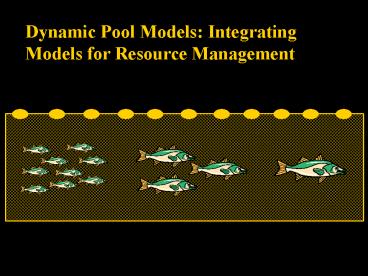Dynamic Pool Models: Integrating Models for Resource Management - PowerPoint PPT Presentation
1 / 14
Title:
Dynamic Pool Models: Integrating Models for Resource Management
Description:
... of a typical dynamic pool model. Explain additional population structure in dynamic pool models ... remember life tables. larvae, juvenile, adult (reproductive) ... – PowerPoint PPT presentation
Number of Views:225
Avg rating:3.0/5.0
Title: Dynamic Pool Models: Integrating Models for Resource Management
1
Dynamic Pool Models Integrating Models for
Resource Management
2
Lecture Goals
- List the four components of a typical dynamic
pool model - Explain additional population structure in
dynamic pool models - Define and explain the rational behind F0.1
3
Population Structure
- Different Ages or Stages
- remember life tables
- larvae, juvenile, adult (reproductive)
- and now Recruits - caught by fishery
- Varying rates for each stage or age
- reproduction
- growth
- natural mortality
- harvest
4
We want to include age/stage structure in an
explicit model of the population under harvest.
QUESTION When to harvest (what age/stage) to
obtain maximum biomass or 'yield' ?
Observed total biomass is a product of individual
growth and mortality (opposite effects)
5
Processes Modeled
- Also environmental influences on
- growth, recruits, natural mortality
- Predation included in Natural Mortality
- Fishing impact on growth through alteration of
age structure - Management alters Fishing Mortality
A Fishery System Model
6
Recruitment Model
- Represent process as
- Random or single constant value
- Beverton-Holt (Constant over range)
- others (e.g. Ricker)
Pacific Halibut, IPHC Data
7
Growth Model
- Length as an asymptotic function (of time)
- Parameters (L0 , L? , k) estimated from field
data of size-at-age
When L0 0 Lt L? (1 - e -kt)
Von Bertalanffy Growth
8
Fishing Mortality
- F Fishing Mortality Rate
- Exponential decay function
- Translate to per unit of time by
- mortality 1 - e -F
F is a function of effort (f) catchability (by
age) qa Fa qaf
9
Natural Mortality
- Modelled mathematically like F (exponential)
- Magnitude is often unknown or poorly known
- Biotic components
- competitors, predators, prey
- Abiotic components
- temperature, humidity, mechanical disturbance
- usually related to meteorology
- Estimated as
- constant all ages
- constant by age
- age specific
- stage specific
- Estimated by
- mark-recapture experiments
- empirical relationships
- body size, temperature
10
Combine Submodels into a Single Model (based upon
data assumptions)
11
Complete dynamic pool model allows potential
impact of management decisions to be evaluated.
- Management can act on
- Age of Entry to fishery
- via gear
- mesh/hook size
- Fishing mortality
- via effort
- time fished
- vessels/nets/etc.
- both?
7
2
below age 2 not caught
12
3-D perspective
Age-at-selectivity Age of Entry YPR yield per
recruit
Figure 10.3 Isopleths describing the response of
Macrodon ancylodon (King Weakfish)
yield-per-recruit to different combinations of
fishing mortality and age-at-50-selectivity.
Analysis was conducted using a single-gear model
with the base case scenario where M 1.2
www.fao.org/docrep/003/Y1715E/y1715e06.htm
13
Interpreting The Yield Per Recruit Contours
Yield / Recruit
Fishing Mortality
Yield / Recruit
Fishing Mortality
14
F0.1 - a cautious approach
- Yield per recruit approach may ignore
- stock size - recruitment (but pre-recruit
surveys) - variability in parameters
Always have uncertainty! (unquantified
variability)
Alternative is F0.1 which is always LESS than the
predicted optimum.































